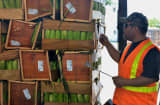
Corn and wheat prices are tumbling and commodity market experts say they could be set to fall even further.
From a broad macroeconomic perspective, Britain’s vote to leave the European Union and its impact on the U.S. dollar created a “risk-off” attitude in the commodity market, according Chip Flory, editor and publisher of the Pro Farmer newsletter. Those economic conditions combined with good weather and ample supply of these commodities drove prices down this past month.
“When you look at the combo of risk-off attitude in the commodities world and improving weather and crop conditions, it’s reason to put some pressure on this market,” Flory told CNBC on Wednesday.
Agricultural commodities markets are often affected by weather and by crop conditions, and the main types of investors in the market are hedgers, such as the farmers growing these products and the manufacturers using them, and the speculators, who are outside parties looking to profit from commodity movements.
Phil Streible, senior market strategist at RJO Futures, said the corn crop is off to a great start this year, which is bad news for prices.
“We’re at 75 percent of it is rated good-to-excellent right now. You go back to last year, it was only 69 percent,” Streible said on CNBC’s “Power Lunch” on Wednesday. Those at the end of the corn supply chain and countries importing the crop will continue to watch for prices to bottom out, he added.
On wheat, Streible said leftover supply from last year could cause prices to slide down even more.
“Until a trader sees a bottom or these end users start to step in, we’re probably going to see that liquidation continue,” Streible said. Those price targets will likely be $3 for corn and $4 for wheat, he said.
While corn futures, wheat futures and futures on other food commodities such as soybeans trade on the Chicago Mercantile Exchange, retail investors can more easily take positions on agriculture commodities through ETFs such as the DBA, which tracks agricultural commodities futures — specifically cattle, cocoa, coffee, corn, cotton, hogs, cattle, soybeans, sugar and wheat.
Looking at a chart of the ETF, Craig Johnson, technical analyst with Piper Jaffray, said that any bad news may already be priced in.
“Twenty-five percent of this ETF is related directly to wheat and corn futures, but from our perspective this looks kind of like a shorter term sell-off,” Johnson said on “Power Lunch.”
[“source-gsmarena”]



